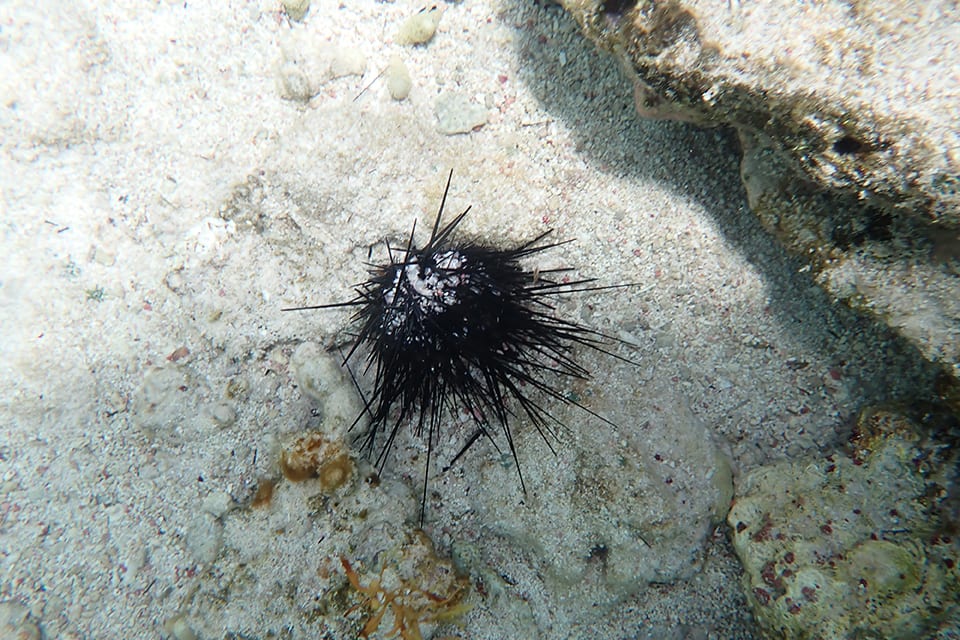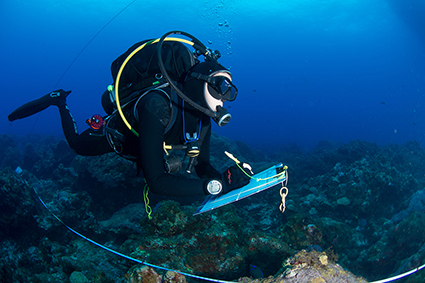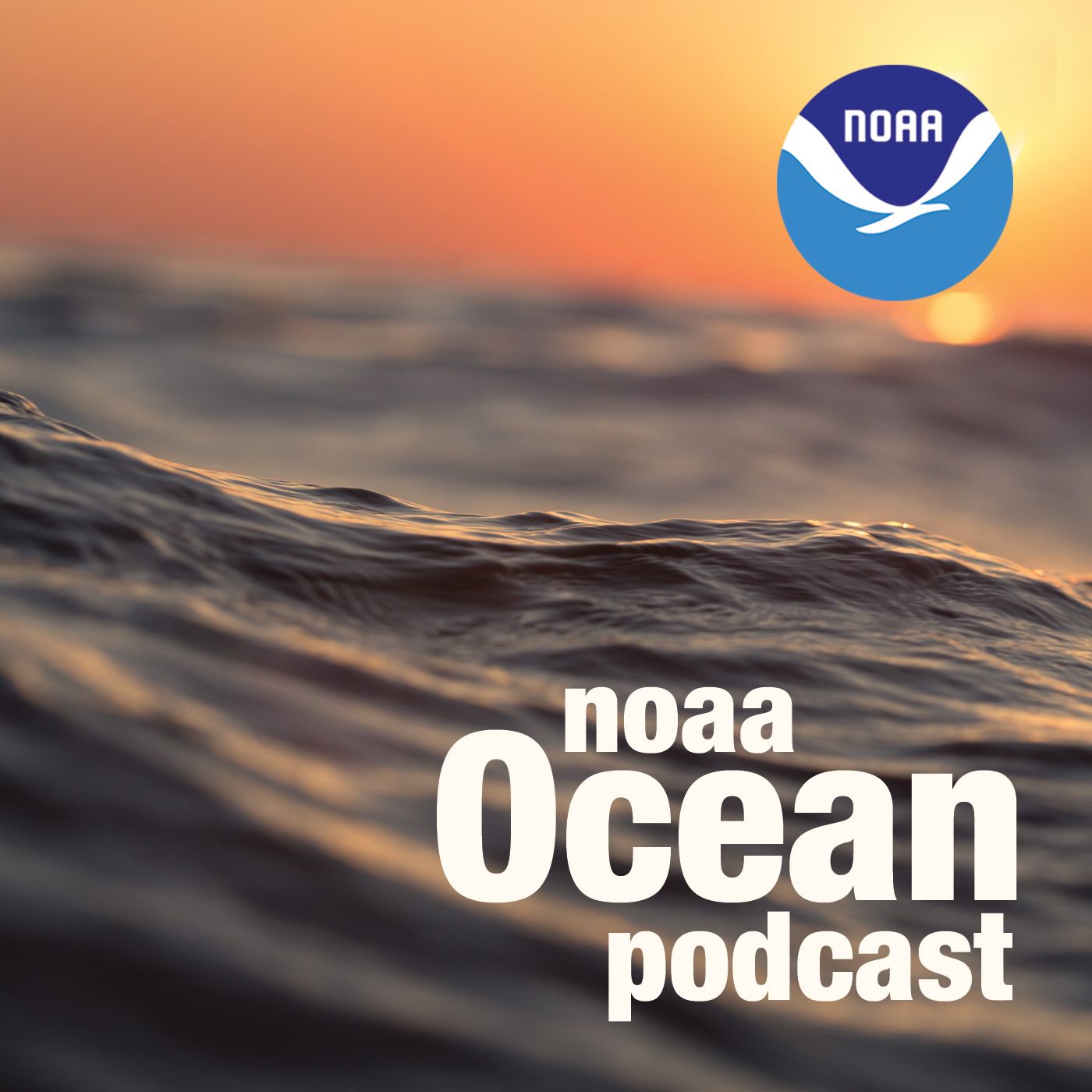Understanding Disease Impacts to Long-Spined Sea Urchins
NOAA Ocean Podcast: Episode 57
In this episode, an expert from NOAA’s Coral Reef Conservation Program discusses a disease affecting long-spined sea urchin populations in the Caribbean. We explore how disease has impacted these organisms in the past, their important role in keeping coral reef systems healthy, and how you can help save them.

Long-spined sea urchin populations in the Caribbean are being affected by a disease. Signs of the sickness include loss of spines (as seen in the photo), excess mucus on their spines, reduced spine mobility, or they may lose their ability to attach to the reef.
Listen here:
Or listen in your favorite podcast player:
Transcript
HOST: This is the NOAA Ocean Podcast. I’m Marissa Anderson. Marine life can be susceptible to diseases just like people. When one group of organisms gets sick, other species, communities, and ecosystems that depend on them can also be impacted. In this episode, we discuss the disease affecting sea urchin populations in the Caribbean, the potential impacts, and NOAA’s role in helping to monitor this event.
We’re joined by one of our experts from NOAA’s Coral Reef Conservation Program, Dr. Erica Towle, who is the National Coral Reef Monitoring Program Coordinator. The Coral Program is a partnership between many NOAA offices that work on coral reef issues. The Monitoring Program is an integrated and focused monitoring effort with partners across the United States. Let’s dive right into the interview.
HOST: Let’s talk about the long-spined sea urchin, also known as Diadema antillarum. Why are they considered an important organism and how are they being impacted by a disease that is affecting their populations in areas of the Caribbean?

Erica K. Towle, Ph.D., National Coral Reef Monitoring Program Coordinator, NOAA’s National Ocean Service, Office of Coastal Management, Coral Reef Conservation Program
TOWLE: The long-spined sea urchin is one of the most important herbivores in Caribbean reef systems and an herbivore means it eats algae. By eating algae, it’s essentially a “cleaner” on the reef - by preventing algal overgrowth so that corals, which of course are the foundation of the reef habitat, have the space they need to grow.
In February 2022, scientists learned of an extensive long-spined sea urchin disease and die-offs in St. Thomas, which is in the U.S. Virgin Islands.
It appears that signs of the disease progress very rapidly and usually within one to two days of signs of sickness, the urchins can die. And what we mean by signs of sickness are things like excess mucus on their spines, they may have reduced spine mobility, or they actually may lose their ability to attach to the reef. And again, after about two days, our scientists have noted that their spines may actually start to fall off and their tissue may sort of slough off, leading to urchin death.
Also, since February, there have been even more mortality events in St. John and St. Croix, which are also in the U.S. Virgin Islands, as well as Puerto Rico, and more than 18 other Caribbean islands or territories.
HOST: Have these events occurred in the past in the Caribbean with the long-spined sea urchin?
TOWLE: Yes, Diadema antillarum previously experienced a region-wide massive die-off throughout the Caribbean in the 1980s.
HOST: What were the causes behind the events that took place in the 1980s and was this species able to recover?
TOWLE: That’s a great question. Sampling at that time in the 1980s was inadequate to fully determine the cause of that disease event, but it appeared to be water-borne and scientists speculate it was transmissible via ocean surface currents. And so the fact that the 1980s outbreak only affected one species, the long-spined sea urchin, it suggests also that a host-specific pathogen could have been involved. Very few Diadema populations have fully recovered even though it has been four decades, so many Caribbean reefs are in this algal-dominated state that I mentioned earlier without the urchins sort of playing their role as cleaners on the reef.
The question of if they can recover is a really good one that’s really important right now. To understand that a little better we have to look back to the previous mass mortality event from the 80s that we just talked about. And essentially, what we do know is that the 1980s die-off reduced populations by 90 percent in many areas in the Caribbean, which reduced the number of urchins that were able to reproduce and regrow the population naturally. But the good news is there were some survivors who were naturally hardy or stress tolerant. And so the hope really now is that because Diadema is a species that has a very wide geographical distribution across the Caribbean and they also have larvae, or baby urchins, that can be carried by ocean currents before they settle on a reef, that they might have the ability to repopulate areas affected by the die-offs.
HOST: That sounds like a huge impact to the urchin populations in the affected areas.
TOWLE: Since the 1980s, some recovery has occurred. It’s just that the recovery levels are still far below where we’d like them to be or where we need them to be. We don’t fully understand the factors that limited higher recovery from the 1980s die-off, but some of them could be related to the fact that adult densities might have been too low to repopulate the population. It could also have to do with the fact that the baby urchins didn’t have a high survival rate, or it could be that there was degraded coral reef habitat that wasn’t good for the baby urchins to settle on. It could also be a combination of all of those things.
Ultimately, we hope that there will be some recovery similar to the aftermath of the 1980s die-off. But there is a lot of concern right now because populations have not fully recovered from the first event and now we seem to be in the midst of another population crash.
HOST: And when you mentioned adult densities that were too low, do you mean just their numbers weren’t high to really support an increased population?
TOWLE: Correct. Meaning that there weren’t enough adult urchins to repopulate and reproduce to make new populations.
HOST: We previously mentioned how the sea urchin is an important herbivore. What would be the impacts to the local ecosystems if this organism’s population did continue to decline?
TOWLE: Losing urchins on reefs is very detrimental to a coral reef ecosystem because it usually means massive algal overgrowth occurs. So when this happens, the algae takes over the spaces that coral would normally grow, and we refer to that as something called a phase shift, where essentially we would go from a coral-dominated reef to an algal-dominated reef. Other scientists also refer to that phenomenon as a “slippery slope to slime”, basically meaning that a reef will transition from what we might be able to picture as a beautiful, pristine coral reef to more of a slimy, algae forest.
HOST: And is it correct to assume a slimy algae forest isn’t the best type of situation for the coral reef?
TOWLE: Yes, exactly, that’s correct. So once a reef goes into this algal dominated phase shift, it’s really difficult to come back from that, and it can take a long time for a reef to recover, if it recovers at all. If all the spaces on the reef is taken up by algae, it’s very hard for coral larvae, or baby corals, to settle and start to grow. So adult corals get overcrowded for space, they may get overgrown by algae. And then once you lose that complex structure of your coral reef, many of the animals that rely on coral reefs as their habitat will have nowhere to live. So for example, many fish species that live on coral reefs would lose their home. If fish disappear from the reef, that can actually affect food supply for people that rely on fishing to feed their families. So it's actually a food insecurity issue. Additionally, the structure of a coral reef habitat provides a very important protection from storm surge to the coast. So without coral reef structure to reduce wave action from storms on to the shoreline, the coast is going to face greater damages when we have severe storms like hurricanes for example. So essentially, yea, losing urchins can actually have a lot of very serious and very negative consequences even beyond the local coral reef itself.

The National Coral Reef Monitoring Program is contributing to monitoring the health of the sea urchins along the entire Florida Reef Tract and Flower Garden Banks National Marine Sanctuary in summer 2022. If divers observe a sea urchin, they will note whether it is healthy, diseased, or dead. This information will be shared with NOS partners and colleagues at the Atlantic and Gulf Rapid Reef Assessment.
HOST: How is the National Coral Reef Monitoring Program working to understand the causes of the sea urchin die-offs?
TOWLE: So firstly, the nature of the design of our monitoring protocol is very well suited for regional-level observations on current reef conditions. More specifically, the program is going to contribute to monitoring the current Diadema mortality event by adding a visual assessment of long-spined sea urchin health condition to our current monitoring protocol. So this work is going to occur along the entire Florida Reef Tract and the Flower Garden Banks which is in the Gulf of Mexico during this coming summer 2022 field season. What that means is that if divers observe Diadema, they will note whether the individual urchin is healthy, diseased, or dead. And then program field surveyors will essentially be acting as “eyes in the water” and report disease observations immediately to our partners and colleagues at the Atlantic and Gulf Rapid Reef Assessment, which has developed something called the Diadema Response Network. The Diadema Response Network is a collaboration of numerous organizations and individuals that are contributing information and guidance on how to monitor, how to collect samples, and basically, how to respond to the Diadema sea urchin mortality event.
HOST: Can these events be prevented in the future?
TOWLE: Unfortunately, because we don’t fully understand what’s causing the disease, it’s difficult to say how we might prevent these disease outbreaks from happening in the future. But, what we do know is that we can do our part to stop polluted runoff from smothering corals. We can use sustainable fishing practices. By that I mean only taking what we need. And also reducing our carbon footprint by saving energy in our homes. And all these actions will help coral reef ecosystems be more resilient when they face new threats like disease.
HOST: Are there other opportunities for the public to get involved in to help?
TOWLE: If you live in Florida or the Caribbean and if you like to go diving or snorkeling, if you come across an urchin that looks sick or dying, you can report it to the Diadema Response Network by emailing them using the email address Diadema@agrra.org. And you know, other things you can do is, you can make sure not to touch urchins or really any reef life for that matter, and rent your snorkeling or dive gear locally. But if you do use your own gear, make sure you clean and disinfect it properly after each use to be extra safe to reduce the chances of spreading the disease from reef to reef.
HOST: And what about people who don't live near the ocean or who don’t dive or snorkel? How can they help?
TOWLE: The number one thing I’d say to that is you can educate other people about the importance of coral reef ecosystems and the threats they’re facing. I really believe that we can’t achieve conservation without an informed and engaged public, so one of the greatest things you can do for this cause is tell your friends, family, and colleagues about it.
I’ll leave you with one piece of hopeful news which is that many scientists, even prior to this most recent disease outbreak, are working on active long-spined urchin restoration, which means urchins are grown in a laboratory aquarium until they are large enough, and then they are put back into the wild. And what’s also really exciting is that coral restoration is also actively occurring, and if you’re interested in learning more about that you can visit NOAA’s Coral Restoration webpages.
HOST: Be sure to check out our show notes to learn more about the Coral Reef Conservation Program, and how you can report healthy or sick sea urchins through the Diadema Response network. Subscribe to us in your podcast player of choice, and dive into our episodes! This is the NOAA Ocean Podcast, thanks for listening.

From corals to coastal science, connect with ocean experts to explore questions about the ocean environment.
Social